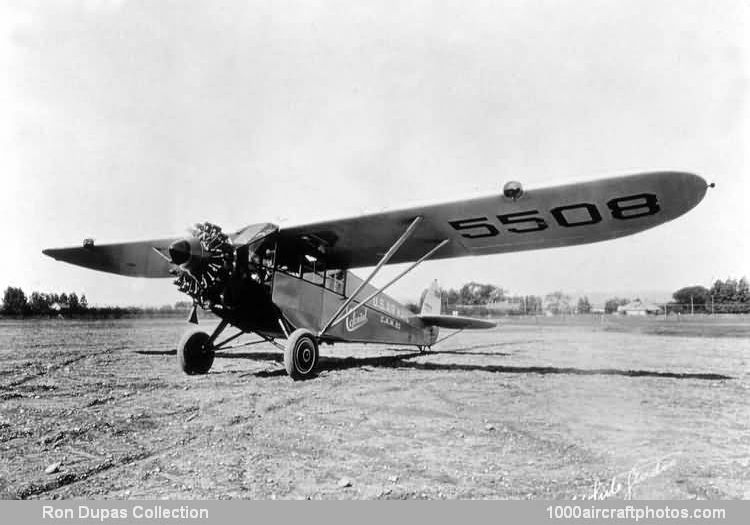The production model FC-2 was powered by the 220 hp Wright J-5 Whirlwind radial, an engine that would make history in a few months when Lindbergh's J-5-powered Spirit of St. Louis reached Paris. The new engine made possible an expansion of the passenger compartment; the FC-2 could carry four passengers in addition to the pilot, and there was more room for baggage. For passenger comfort, a cabin heater was installed and the cabin door size was also increased. Initially the three-longeron fuselage had a "razor-back" top line, as pictured above, a squarer four-longeron body appeared on later aircraft.
But the innovations of the FC-2 were not all in the passenger compartment. An oil-and-spring oleo shock absorber was incorporated into the landing gear to improve landing performance. It was to remain a standard landing gear system for twenty years. Foot-actuated wheel brakes were added. And a system for quick conversion to pontoons was available as an option.
By June 1927, the Fairchild plant at Farmingdale, New York was delivering production aircraft, the model FC-2. The six aircraft for the first major customer, Curtiss Flying Service, were fitted with 160 hp Curtiss C-6 engines and designated FC-2C. Another early customer for the FC-2 was the US Department of Commerce, then the approving authority for all aircraft and engines, as well as of civil aircraft regulations. The Commerce airplane was delivered just five weeks before Lindbergh's daring solo flight across the Atlantic. On Lindbergh's subsequent triumphal tour of the USA, the department's newly acquired FC-2 was chosen to transport staff people and personal baggage and equipment.
A few months later another FC-2 became the first to carry international air mail on a Pan American World Airways contract flight. Pinch-hitting for not-yet-delivered Fokker Tri-motors, an FC-2 carried 300 pounds of mail from Key West to Havana.
But the FC-2 attained its greatest and most enduring fame in Canada where its outstanding flying characteristics were instrumental in opening the northern bush country. The Canadian government was trying to administer the vast reaches of its dominion and had found aircraft to be the only answer. The seaplanes available could get into many areas only during the warm season, when lakes and rivers were not frozen. The FC-2, adaptable to wheels, skis and pontoons, eliminated these seasonal limitations. It was made-to-order for the job. The demand for the FC-2 became so great that a Canadian aircraft builder, Canadian Vickers Ltd., was licensed to produce it there. However, in the end only twelve were produced in Canada, of which two were sold as spares.
In all, about 160 civil FC-2s were built. With engine changes, Frise-type ailerons and other modifications, a number FC-2s later received the Model 51 designation under a different type certificate.
Pictured above is one of four FC-2 aircraft operated by Colonial Western Airlines, they flew a route from Albany, New York, USA to Cleveland, Ohio, USA."
|
Write us about your aerial problem. |
